Natural Environment: Saving an Essential Part of Hawaiʻi
Here are five stories on how we can prepare for the present and the future, and what individuals, businesses, nonprofits and governments are doing to protect our natural environment.
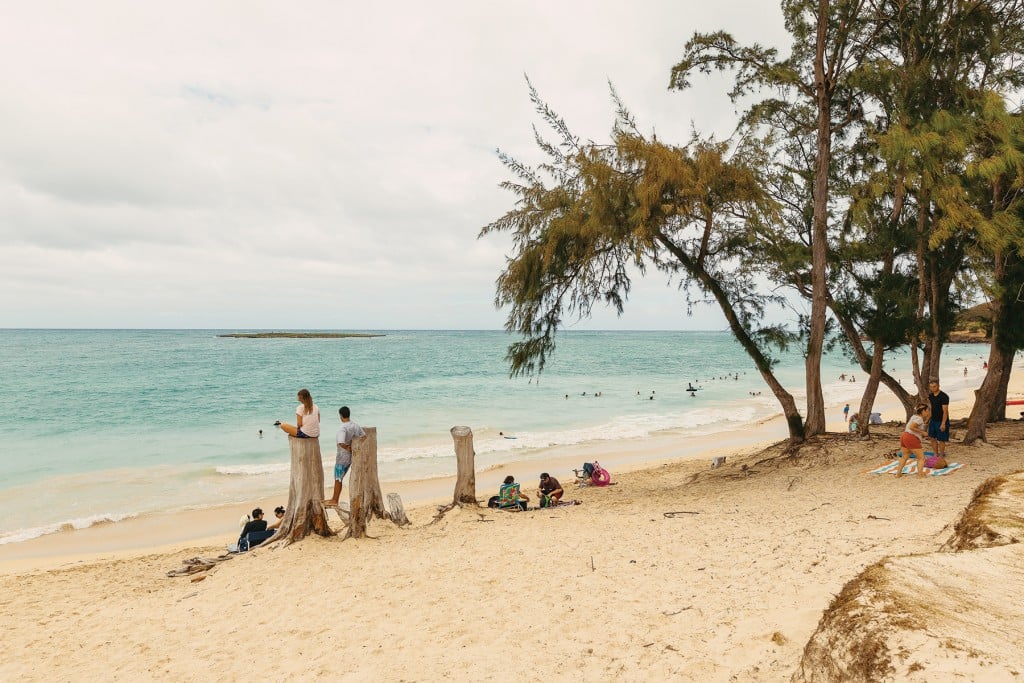
Part 2: Six Ways to Deal With Our Disappearing Beaches
By LiAnne Yu
Beach erosion shows up in many different ways.
For Kahi Pacarro, it’s in the gradual changes he has observed over time as a surfer. “You first start seeing the roots of the trees closest to the water become exposed. Then you see the trees die. You see the disappearance of sand and the exposing of rocks and sandstone. Then you begin to notice that there’s a smaller area for kids and locals and tourists to lay down their towels,” says the CEO of Parley Hawaii.
For Pat Lindquist, it’s in a photo of Napili Bay from 1971, featuring a wide, flat, white-sand beach that contrasts starkly to what she sees today. “There are times now when there’s no dry beach. The waves come all the way up the edge of the greenery on our properties,” says the president of Napili Bay and Beach Foundation.
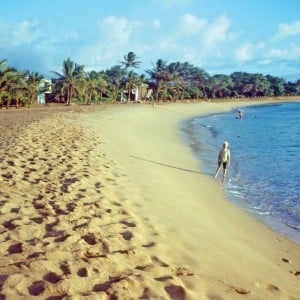
The beach is seriously eroding at Maui’s Napili bay: Shown in 1971 (top) and today (bottom). | Photos: Courtesy of Pat Lindquist
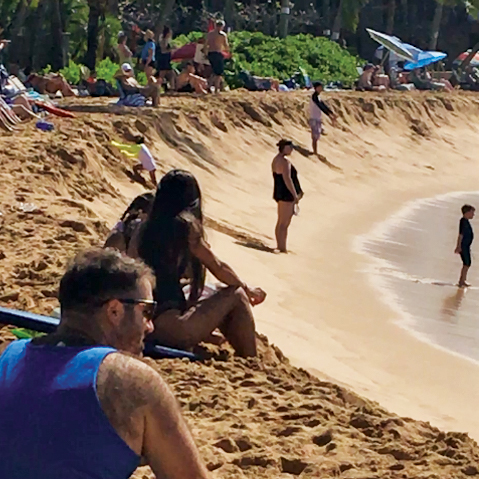
For Jim Howe, it is in nearly every aspect of his work as director of the Honolulu Emergency Services Department. “For the last 15 years, we’ve been retreating across many different beaches around the island, moving the lifeguard towers back over and over and over again.”
Sandy shorelines are never static as they undergo seasonal changes, generally shrinking under the influence of energetic waves and recovering with the return of calmer conditions. Nonetheless, coastal specialists and communities agree that what is happening today goes far beyond these cyclical transformations. Hawaii’s beaches are visibly narrowing and disappearing.
“We are seeing the gnarliest instances of erosion in our lifetimes,” says Pacarro. “At the pace it’s happening on the North Shore, by next year many houses there are going to fall into the ocean.”
Data over the last nine decades on Oahu’s Windward side show that 74 percent of the coast is eroding, 55 percent of beaches have narrowed, and 20 percent of beach length has been lost. Overall, at least 60 percent of Oahu’s coastline and 80 percent of Maui’s are in states of chronic erosion. Scientists say that at this rate, most of Hawaii’s beaches could disappear by the middle of this century.
Beach and coastal erosion threaten infrastructure, private property and the heart of our tourist economy, but Hawaii’s experts acknowledge we are only at the early stages of figuring out what a proactive and systematic approach will be, beyond piecemeal fixes for specific emergencies.
Nonetheless, says Howe, we can’t afford to take a wait-and-see approach. “We are under an existential threat and we have a choice to make. The choice is going to be which beaches are we going to save and which ones are we not going to have anymore. To do that, we have to make some value judgments about what’s most important to us. And right now, we don’t have a clear path forward on how to make these decisions.”
Here’s what Hawaii’s coastal environment leaders says are the six most important things we need to do to create an effective long-term strategy to address our disappearing beaches.
1. Integrate sea level rise into our policies
West Maui is one of Hawaii’s pre-eminent resort destinations. It also has one of the most rapidly eroding coastlines. Several condominiums in Kahana are under imminent threat. “These are massive, high density developments, in total nearly a thousand units, all about to fall into the ocean,” says Tara Owens, coastal processes and hazards specialist at the UH Sea Grant College Program.
Most of the properties in the area were built in the 1970s, before there was a statewide coastal management process, and before knowledge of the effects of climate change were broadly acknowledged. “Moving forward, we need to understand all the conditions we’re going to face. And to do that, we need to understand sea level rise,” says Owens, who also works with the County of Maui Planning Department.
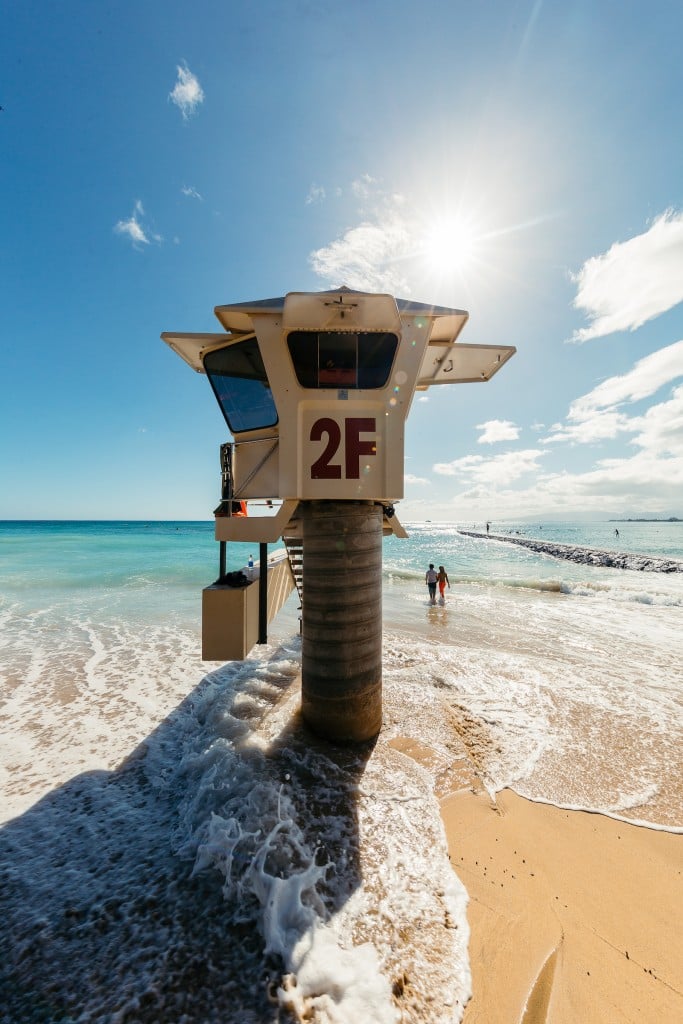
Photo: Aaron Yoshino
Global warming is causing sea level rise as polar ice melts and oceans expand. There are a range of projections for the magnitude and timing of sea level rise, with a worst-case scenario of 8 feet by the end of the century. Based on research, the Honolulu Climate Change Commission issued guidance saying that it’s reasonable to set 3.2 feet of sea level rise as a planning benchmark for the end of the century. They further advised that because of uncertainties in forecasting future warming, six feet should be used for large projects with low risk tolerance, such as public infrastructure.
On the basis of research from the National Atmospheric and Oceanic Administration (NOAA), the commission also advised to plan for disruptive high tide flooding. As seas rise, waves become larger and extend farther onto land, and their impact becomes exponentially greater. Last year’s king tides broke the state’s 112-year-old record, rising up to 12 inches beyond predicted levels.
In addition, the warmer the environment, the more intense and frequent heavy rain events are, and the closer hurricanes will come. In 2015, the ocean water around Hawaii was 2 degrees warmer than normal, and in that year, 15 hurricanes approached the Islands.
“Sea level rise causes beaches to move landward. Beaches can survive if there’s a sand supply and nothing in the way. However, generally speaking, in West Maui there just isn’t a sand supply in the back-shore area. We’re actually getting to the point where we’re running out of beach and land in front of buildings and infrastructure. That contributes to the erosion impacts we’ve seen,” Owens says.
In response to the recent experience with impacts to properties and infrastructure built too close to the shoreline, the Maui County Planning Department has proposed new shoreline setback rules for all coastal developments. The new erosion hazard line, produced by a research team under UH Manoa professor Chip Fletcher, would incorporate future erosion from sea level rise projections; in areas where hazard lines are mapped, the shoreline setback would be the erosion hazard line plus 40 feet inland.
These new coastal development rules would be the first in Hawaii to incorporate sea level rise. Although Mayor Kirk Caldwell has directed all executive departments and agencies of Honolulu to use the climate commission’s guidance in their planning, the statewide coastal zone management law has yet to be updated to explicitly address the issue.
“Our community here on Maui is very highly aware, and a lot of what we’re doing is driven by the community itself. Everyone is interested in doing better than we have in the past,” says Owens. “We’re getting to the point where folks understand that a parcel by parcel response isn’t going to work. When you’re talking about beaches, you have to look at it from a systems perspective.”
2. Engineer solutions that work with the natural environment, not against it
As rising sea levels started to threaten Lanikai, owners reacted by putting up sea walls. These shoreline hardening measures may have saved the homes, but as we now understand, they killed the beach.
“Not many people realize that the sand on the beaches moves in waves just like the water does. There’s a give and take. They are shifting all the time. It’s a living, breathing shoreline,” says Surfrider Foundation Hawaiian Islands manager Stuart Coleman.
When a retreating beach encounters a hard barrier, it has no place to go. The rising sea can no longer draw sand from inland dunes and sandy plains to replenish the beach. As many Lanikai homeowners have witnessed, this disruption of dynamic processes causes the sand in front of the wall to erode away.
Sea walls also hasten erosion in front of adjacent properties, creating a domino effect as owner after owner puts up their own walls to protect their own homes.
“When you see a place like Lanikai, where people have put up hardened sea walls, you realize it’s the worst neighbor policy in the world. When you do that, you’re damning your neighbors to coastal erosion. It’s just the way the ocean works,” says Coleman.
But there are other structures that can offer better solutions, says professor Kwok Fai Cheung of UH Manoa’s Department of Ocean and Resources Engineering. “Sea walls destroy beaches, there’s no question about it. But that shouldn’t discourage us from exploring other, more careful designs that can maintain the beach and protect the coastline at the same time.”
Cheung points to Iroquois Point Beach, adjacent to the west side of the Pearl Harbor entrance channel. It had been suffering from such extreme beach erosion that over a dozen houses had to be removed.
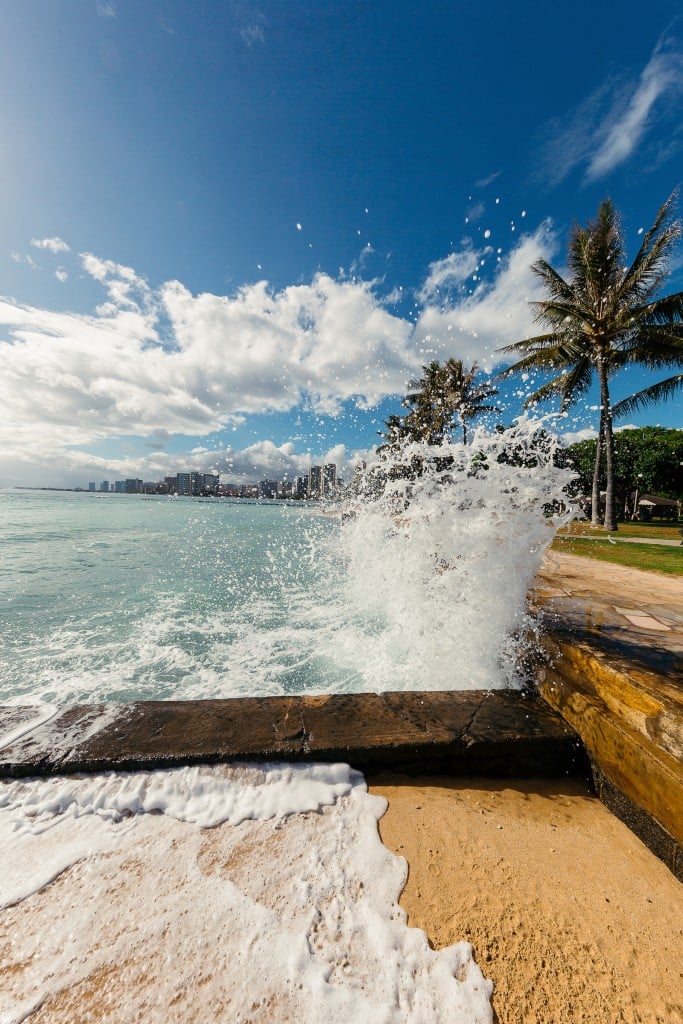
Photo: Aaron Yoshino
Sea Engineering Inc. VP Scott Sullivan was hired to develop a solution. An analysis of the site concluded that the expected solution was not the best one. “Some of the environmental resource agencies said, ‘Well, just build a sea wall. It’s a smaller footprint and will have less impact on the marine environment. And it’s cheaper.’ But we argued, ‘No, this is a beautiful sandy shoreline, and it can be preserved.’
“In the end, our arguments prevailed,” says Sullivan.
Their strategy involved stabilizing the beach with nine T-head rock groins, or what Cheung calls Y-groins because of the way they look. Rather than hardening the shore and disrupting dynamic processes, these structures reduce wave height and severity.
“Big waves that break on the shore move the sand away from the beach, resulting in erosion,” explains Cheung. “But when the waves are small and don’t break, they actually push sand back onto the beach.”
Cheung says that for urbanized areas that we are unwilling to retreat from, such solutions can offer a path forward. While these structures would add a massive artificial element to the beach, he says that in Japan, they have been designed to blend in with the natural environment and create attractive walkways for beachgoers.
As for Iroquois Point Beach, “We’re now five years post-construction, and the beach has not changed at all. It’s been perfectly stable,” says Sullivan.
Oceanit coastal engineer Mike Foley is also working on human-made solutions that work in harmony with dynamic environmental processes while dissipating wave energy. He has done research on the next generation of artificial reefs that could be attached to fringing reefs to raise their elevation. These reefs could then host complex ecosystems of fish and thermal-resistant corals.
“That’s where the union of different sciences and engineering can come together. We need marine biology to understand the ecological complexities of reef life, as well as civil and ocean engineering for construction knowledge. Instead of building walls or retreating, we can investigate solutions to enhance nature’s own forms of resiliency,” says Foley.
3. Protect our natural resources so they’ll protect us back
Most conversations about beach erosion focus on what we can do for our coasts. Coleman, the Surfrider Foundation manager, however, wants us to not lose sight of what our coasts can do for us. “The fact is, storms would be much worse if we didn’t have reefs and dunes to absorb that energy. They are like buffer zones for the island. The more we get rid of those, the more it’s like driving around without a bumper.
“People think that we’ve got to protect the reef and shoreline. What they don’t realize is that our reefs and shorelines are actually protecting us from storms.”
Dunes act as a natural buffer to waves and coastal hazards, explains Dolan Eversole, Waikiki Beach management coordinator for the UH Sea Grant Program. “If you think of the beach as your bank account, your checking account is the active beach. It comes and goes. You’re making withdrawals and deposits on a daily basis. And then every now and then something big happens and you have to dip into your savings. And that’s when the dune supplies the beach with new sand.”
Jodi Wilmott, who’s lived on Oahu’s North Shore for 20 years, has seen the deterioration of these critical resources. “The change along that stretch between Ehukai and Sunset is quite visible to people who have been here a long time. The dune system has been destabilized. It doesn’t recover the way it used to. Even if the sand returns, it just isn’t as densely packed and resilient to swell episodes as it once was,” says Wilmott, the World Surf League’s GM for Hawaii and Tahiti Nui.
A number of public and nonprofit groups, including the World Surf League, North Shore Community Land Trust, Surfrider Foundation and UH Sea Grant Program, have partnered to restore and protect these dunes. Their efforts on Sunset Beach include pushing sand from lower down on the beach back onto the high dune profile, planting vegetation for stabilization and building walkways across the beach.
Like dunes, coral reefs are a natural form of protection, dissipating up to 97 percent of wave energy. However, when corals are stressed by changes such as rising temperatures, they expel the symbiotic algae living in their tissues, causing them to turn white – a phenomenon called coral bleaching. Corals can sometimes survive a bleaching event, but it puts them under tremendous stress. According to the Nature Conservancy, up to 90 percent of some reefs around Hawaii Island died in response to record ocean surface temperatures in 2014 and 2015. Researchers have projected that reefs around Hawaii may begin experiencing annual bleaching as early as the 2030s.
To address this, Hawaii Institute of Marine Biology program manager Kira Hughes is working on developing more resilient corals – so-called super corals. Her research, funded by Paul G. Allen Philanthropies, involves selectively breeding corals that were tagged around Hawaii’s coasts for their ability to survive the 2015 bleaching event.
“We’re trying to produce offspring that are even stronger than their parents because thermal tolerance traits have been passed on to them,” says Hughes. “Once you put out more resilient corals, they’ll breed. And through their natural breeding cycle, they will continue to increase their ability to resist temperature stress.”
Her research is also focused on how to make coral more physically fit, so to speak. By exposing them to temperature stress, she can see which genotypes are the most resilient. “If you are an athlete, you train for your big event in order to perform better. It’s the same idea. We’re exposing corals to temperature stress and seeing if that will make them stronger the next time,” says Hughes.
4. Understand that beach restoration is complex and temporary
Howe, the director of Honolulu’s Emergency Services Department, remembers when Fort DeRussy Beach was first restored in the early 1970s. “I saw the new beach getting trucked in. They used crushed coral, which was brighter than sand and had little rocks in it that weren’t pleasant to step on. It also caused the water to go milky for a long time. And well, that was it. There was nobody there with their towels anymore, no families picnicking or people playing Frisbee.”
Waikiki Beach’s 2012 restoration, he says, resulted in a much better experience for beachgoers. To maintain the iconic look and feel that people expected, the state spent $2.9 million to dredge 27,000 cubic yards of sand from offshore to extend the beach by 37 feet.
Beach restoration, however, is much more complex than just finding some sand and spreading it around, stresses Waikiki Beach management coordinator Dolan Eversole. The sand has to match the characteristics of the beach. The higher the wave energy on the beach, the larger the grain size. Too fine, and it gets washed away. The wrong consistency, and other organisms, such as nesting turtles, may suffer. Imported sand typically comes from mountain erosion, while Hawaii’s sand originates from the ocean. Mixing the two could have detrimental consequences. Even if there happens to be good quality sand just offshore, it could be the wrong color or contain organisms that will be disturbed.
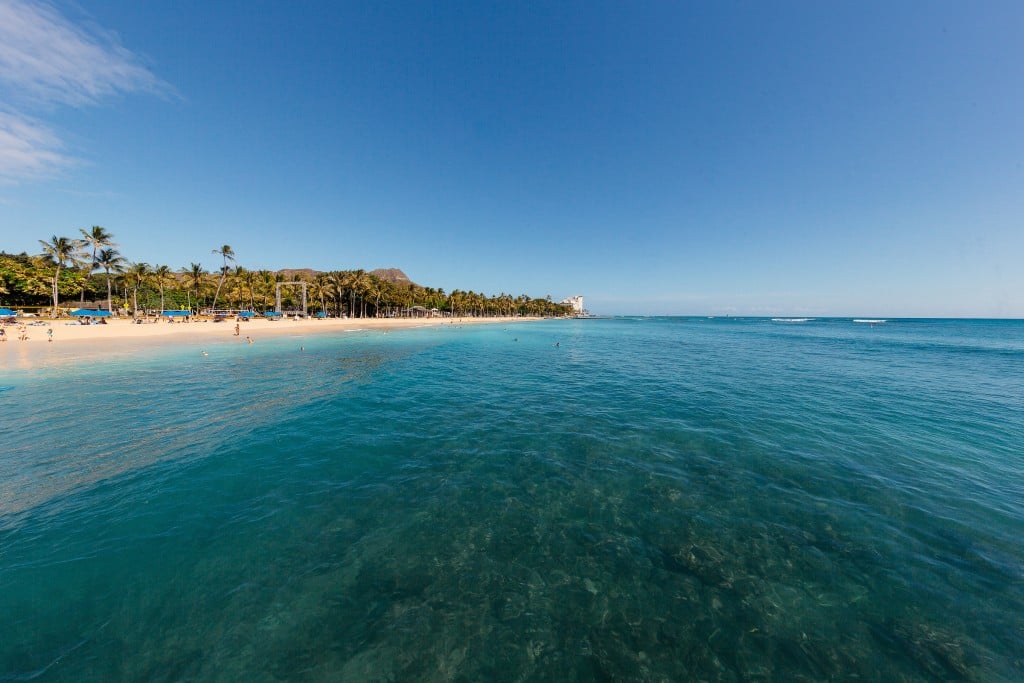
Photo: Aaron Yoshino
Beach restoration is also not a permanent solution and may change beach dynamics in unintended ways. “Within two years some of the new sand was deposited offshore, creating a big sandbar,” says Howe, describing what happened at Waikiki Beach. “That sandbar creates attractive places for people to wade onto. But then unfortunately it drops off. So, we’ve had to rescue thousands of people out there.”
Lindquist, the Napili Bay and Beach Foundation president, says her community has been told that restoration will likely cost somewhere between $1 million and $2 million, then less for subsequent refurbishments. While it is unclear how this will be paid for, 6 of the 10 resorts on the bay have contributed to a beach restoration fund.
Lindquist says that her community wants to explore all creative options, including artificial reefs and oyster beds to diminish wave intensity. But recapturing the look and feel of the beach is, she acknowledges, a high priority. “It’s a very special beach for many of us. There’s that beautiful, low-rise, older Hawaiian-style feel that’s highly valued by us who own and come here. It’s just a grand place to swim, snorkel and surf. And to be brutally honest, there’s a financial component in terms of property values.
“So right now, we’re going to do everything we can to help preserve the beach that we love,” she says.
5. Get real about getting out of the way
Chip Fletcher believes that as we formulate our strategy for what we want to do, we have to remember that the beach will do what it must. “If you are a beach, your entire identity is based on being located at the edge of the ocean. If the ocean is rising, you have one alternative and one alternative only to stay alive. You have to migrate landward,” says the associate dean for academic affairs and professor at UH Manoa’s School of Ocean and Earth Science and Technology.
Sea level rise doesn’t in and of itself erode beaches, he says. Coastlines that are allowed to erode on their own will continue to give us beaches as long as they are allowed to move and access sand from dunes and coastal plains without obstruction.
“If our coastal management is, as it says it is, intended to protect existing beaches for future generations, then it must be reflected in policies that allow beaches to migrate landward with the rising seas,” says Fletcher.
“If we’re serious about saving our beaches, it’s our job to get out of the way.”
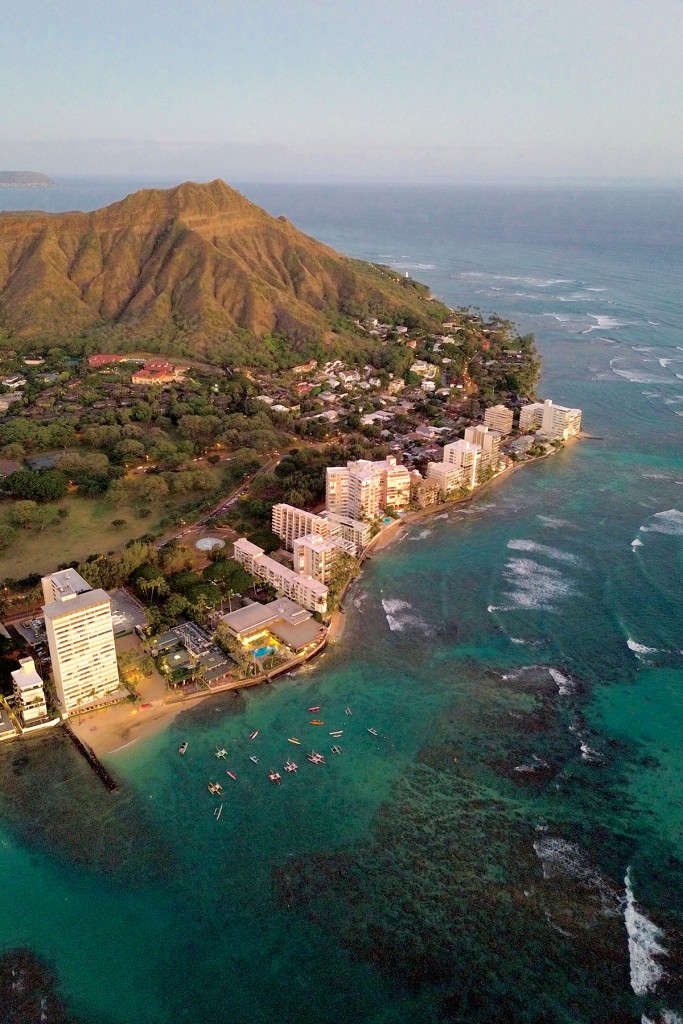
Photo: Getty Images
So what about getting out of the way as a solution? Managed retreat, or the planned process of moving people and infrastructure away from vulnerable shorelines and discontinuing any new development there, is a difficult topic for many.
It is difficult for property owners because it can mean the loss of money, community, generational investment and all of the emotional and cultural attachments people have to their homes.
For Hawaii’s leaders, it is difficult because we don’t yet know how it should happen and what the costs would be.
“We had started out this project thinking that we could do research on successful retreat that had taken place in other locations on the Mainland and internationally. And that we could do a checklist of sorts to figure out how to do it here. But as we delved into the issue further, we found that we’re just at the start of this very challenging, complex discussion,” says Justine Nihipali, who worked on a recently released report on managed retreat strategies in her role as planning program manager for the Hawaii Coastal Zone Management Program.
There are a few examples to study, including the successful retreat of downtown Hilo after the 1960 tsunami, the retreat of a number of homes after Superstorm Sandy in New Jersey, and the retreat of a bike path in Ventura County, California. Their specific circumstances make them informative but not ideal models to follow, say Nihipali and project analyst Sandy Ma.
They point to one of the biggest challenges: There simply isn’t a lot of space in Hawaii to retreat to. Competing uses for those lands include agriculture, the military and conservation.
There are also a multitude of questions around how to actually get people to move. “Should public dollars be used to fund purchasing of at-risk properties? If so, who gets a share of that? The homeowners that have very high property values, or others that are at risk that also might need support? And who makes that determination? There are many social justice issues at play,” says Nihipali.
Ultimately, they say, managed retreat must be a conversation that happens at all levels, and not just among policymakers. “This is bigger than any one agency can speak to alone. Communities will need to be educated about the risks that we are facing and take ownership in getting informed, and then work with the government to move forward,” says Nihipali.
6. Define the long-term value of our beaches
While Hawaii has strong coastal management policies on paper, the more immediate economic interests of coastal development too often drive our decision-making, says Sam Lemmo, administrator for the state DLNR’s Office of Conservation and Coastal Lands.
Honolulu laws, for example, allow beachfront property owners to claim a hardship exemption in order to get permission to build sea walls, as well as to continue renovating and expanding already existing properties even in areas deemed too risky for new development. These developments include not only private homes and property, but public roads, parks and federal land.
“One problem has been our inability or unwillingness to take our coastal policies seriously. Our policies suggest that decisions regarding coastal development need to be weighed in terms of their impact on the beaches. But what we find is that these policies tend to be overlooked or minimized in favor of coastal development,” says Lemmo.
He points to various economic reasons why coastal development gets preferred treatment over beaches: the interests of homeowners, the real estate industry as a tax base and the speculative element of many coastal properties as short-term rentals.
“We know in our hearts that beaches are important for our economy, because without them, our economy wouldn’t be what it is. Yet their value isn’t as real to us as the value of coastal property,” Lemmo adds.
One study valued Waikiki Beach at $2 billion a year, but that number is focused on the visitor economy and doesn’t account for the beach’s value to locals, as well as its value beyond strictly economic terms. What about a beach’s cultural and historical values, or the role it plays in terms of family memories? What about a beach’s value in terms of clean water and abundant fish? What about a beach’s ecological value to organisms other than humans?
“In a perfect world, I’d love to save every beach. But it is very hard to remove the subjectivity from the question of which beaches are most important,” says Bradley Romine, coastal management and resilience specialist for the UH Sea Grant College Program.
“While it helps our decision-makers to have dollar figures in terms of the value of our beaches, I often come back to the philosophical question of, ‘Can we really value some of these ecosystems or are they actually priceless?’ ” says Romine.
But if we don’t figure out how to define those values for the long term, we risk having other interests with clearly defined values being given higher priority in our short-term decision-making.
For lifelong surfer Wilmott, there is no better way to remind herself of how important it is to take the long view than when she’s out on the water. She describes an experience she had paddleboarding to illustrate her point. “It was a completely different perspective to me, going from 50 to 150 feet from shore as a surfer, to half a mile or more paddleboarding. I was able to get the perspective of being completely disconnected from land while also having, within one frame of visual reference, the island, the shoreline, the people, the houses and the ocean all in one view plane.
“Now more than ever, our way of life requires us to up-periscope more often, and really survey our surroundings from a more holistic view of where we want to go. It’s very easy to lose time. And it’s impossible to regain it. So, we must look far ahead right now. The further we can cast our view, the better.”
Quicklinks
Part 1: Resilience
Part 2: Six Ways to Deal with Our Disappearing Beaches
Part 3: Oceans of Debris
Part 4: How to Make Your Company Green
Part 5: Zero Waste
Ongoing Efforts and Other Resources






